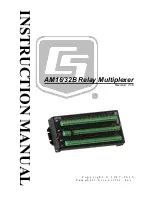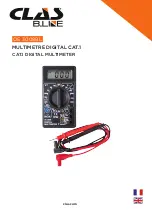
28
29
EN
EN
4. If you wish to test a diode, connect the
red test wire to the anode part of the
diode and the black test wire to the
cathode part of the diode.
5. Then read the value off the display.
Note:
If the polarity of the test wires is reversed
relative to the polarity of the diodes or if
the diode is damaged, then „ “ will be
shown on the display.
•
WARNING
y
Do not supply voltage under
this setting.
y
Before testing a diode, disconne-
ct the power supply to the circuit
and discharge all capacitors.
Capacitance measurement
1. Connect the black test wire to the COM
terminal.
2. Repeatedly press the function selection
button (fig. 2, position 1) until
appears on the display.
3. Repeatedly press the
Select/On&Off
button (fig. 2, position 5) until the
symbol
is shown on the display.
4. If you wish to cancel the automatic
shut-off function, hold down the button
SELECT while turning on the device.
When the cancellation of this function is
performed correctly, the device will beep.
5. Read the measured capacitance value
off the display once this value stabilises.
•
WARNING
y
Before testing capacitance,
disconnect the power supply to the
circuit and discharge all capacitors.
Frequency measurement
1. Connect the black test wire to the COM
terminal.
2. Repeatedly press the function selection
button until appears on the display.
3. Repeatedly press the Select/On&Off
button (fig. 2, position 5) until the
symbol
Hz
for frequency measurement
is shown on the display.
4. Touch the required measurement points
with the tips of the probes.
5. Read the measured the frequency value
off the display.
y
The frequency mode relates only to
measuring frequency in the range
1 Hz ≤ 6 MHz for voltages < 36 V~.
Non-contact detection of voltage NCV
1. Repeatedly press the function selection
button until appears on the display.
2. Press the button Select / On&Off button
three times to enter the NCV mode
(symbol EF is shown on the display).
3. Hold the device and move it around.
When the device detects alternating-
-current voltage in the vicinity, the built-
-in buzzer will start emitting an inter-
mittent sound and the display will light
up intermittently, and the greater the
voltage the greater will be the frequency
of the sound and the flashing display.
•
ATTENTION
y
NCV detection is only indicative, and
detection is dependent on shielding by
the environment. If the device does not
detect voltage with the NCV method,
it does not necessarily mean that there
is no live conductor under voltage or
that there is no life threatening voltage
inside the conductor in the tested loca-
tion (e.g. inside a wall); this depends on
the distance.
Maintenance
Apart from the replacement of batteries, do
not attempt to repair or modify this device
unless you have the appropriate qualifi-
cation for the task and unless you know
the relevant instructions for calibration,
performance testing and servicing.
Cleaning the product
Clean the device using a damp cloth and
diluted cleaning agent. Prevent water from
entering the device. Do not use abrasive
cleaning products or solvents. Soils and
humidity on the terminals may affect
measurement results.
y
Prior to cleaning the device, remove the
input signals.
Replacing batteries
In the event that the icon is shown on the
display, replace the batteries according to
the following procedure:
1. Before replacing the batteries, always
disconnect the test wires (probes) and
turn off the device.
2. Loosen the screw on the battery com-
partment cover and remove this cover.
3. Replace flat batteries with new batte-
ries of the same type, whilst inserting
the batteries into the device according
to the designated polarity.
4. Put the battery compartment cover back
on and tighten the respective screw.
TECHNICAL SPECIFICATIONS
Basic Specifications
Display (LCD)
Maximum
value 6000
Range setting
Automatic /
Manual
Material
ABS
Frequency refresh rate
3 times/sec
True RMS
yes
Data retention
yes
Display backlight
yes
Flashlight
yes
INPUT TERMINALS:
COM
COM
Common terminal for all measu-
rements.
INSTRUCTIONS FOR
MEASUREMENT
Measurement of alternating-current vol-
tage and direct-current voltage ACV/DCV
Note:
The symbols shown on the display for the
given measurement mode are provided in
the table above.
1. Connect the black test wire to the COM
terminal.
2. To measure direct-current voltage,
repeatedly press the function selection
button (fig. 2, position 1) until
appears on the display.
3. To measure alternating-current voltage,
repeatedly press the
Select/On&Off
button (fig. 2, position 5) until the AC
symbol is shown the display; to measure
direct-current voltage the symbol DC
must be shown on the display.
4. If you wish to measure voltage, place
the tips of the probes on to the correct
test points of the circuit.
5. Read the measured voltage off the display.
•
WARNINGS
y
Do not measure a voltage the
value of which exceeds the
limit value specified in the
technical specifications.
y
Do not touch the measured cir-
cuit during measurement.
Measurement in the ACmV/DCmV (≤
600 mV) mode
1. Connect the black test wire to the COM
terminal.
2. To measure direct-current voltage,
repeatedly press the function selection
button (fig. 2, position 1) until
appears on the display.
3. To measure alternating-current voltage,
repeatedly press the
Select/On&Off
button (fig. 2, position 5) until the AC
symbol is shown the display; to measure
direct-current voltage the symbol DC
must be shown on the display.
4. If you wish to measure voltage, place
the tips of the probes on to the correct
test points of the circuit.
5. Read the measured voltage off the display.
•
WARNING
y
Do not measure voltage the
value of which exceeds the
limit values specified in the
technical specifications.
y
During measurement, do not
touch high voltage circuits.
Measuring resistance
1. Connect the black test wire to the COM
terminal.
2. Repeatedly press the function selection
button (fig. 2, position 1) until
appears on the display.
3. Repeatedly press the
ON/OFF Select
button
(fig. 2, position 5) until the symbol
Ω
is
shown on the display. It may be necessary
to use the
RANGE
button (fig. 2, position 3)
to change the range of the resistance units
so that the display shows a value, otherwise
„ “ will be shown on the display.
4. If you wish to measure resistance, place
the tips of the probes on to the required
test points of the circuit.
5. Read the measured resistance off the display.
•
WARNING
y
Before testing resistance, disco-
nnect the power supply to the cir-
cuit and discharge all capacitors.
y
Do not supply voltage under
this setting.
Continuity test
1. Connect the black test wire to the COM
terminal.
2. Repeatedly press the function selection
button (fig. 2, position 1) until
appears on the display.
3. Repeatedly press the
Select/On&Off
button (fig. 2, position 5) until the symbol
and
. is shown on the display.
4. Place the tips of the probes on to the
required test points of the circuit.
5. If the buzzer is sounded, the measured
circuit is not interrupted.
•
WARNING
y
Do not supply voltage under
this setting.
Diode test
1. Connect the black test wire to the COM
terminal.
2. Repeatedly press the function selection
button (fig. 2, position 1) until
appears on the display.
3. Repeatedly press the
Select/On&Off
button (fig. 2, position 5) until the sym-
bol of a diode is shown on the display.



































